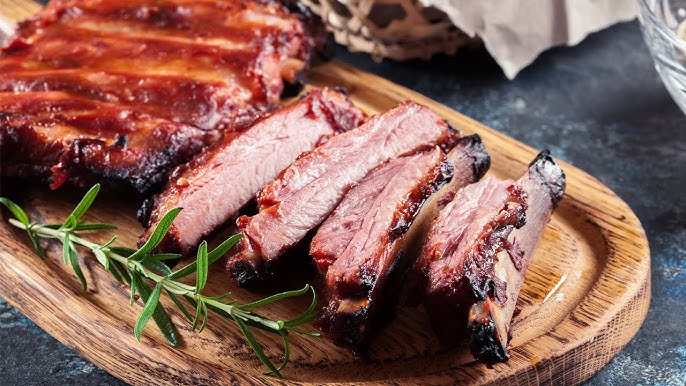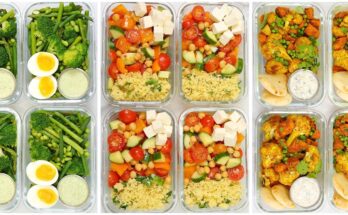Smoked Ribs Recipe: There’s nothing quite like biting into a perfectly smoked rib, with its tender meat falling off the bone and a smoky flavor that lingers on your taste buds. Smoked ribs are the crown jewel of barbecue and a must-try for anyone who loves outdoor cooking. With the right techniques and a little patience, you can create ribs that rival those of the best barbecue joints.
Ready to master the art of smoked ribs? Let’s dive in!
Ingredients for Smoked Ribs
To make mouthwatering smoked ribs, you’ll need the following ingredients:
For the ribs:
- 1-2 racks of baby back ribs or spare ribs
- Olive oil (for binding the rub)
For the dry rub:
- 2 tbsp paprika
- 1 tbsp brown sugar
- 1 tbsp garlic powder
- 1 tbsp onion powder
- 1 tsp chili powder
- 1 tsp ground black pepper
- 1 tsp kosher salt
For the spritz:
- 1 cup apple cider vinegar
- 1 cup water
For the BBQ sauce (optional):
- 1 cup ketchup
- 1/4 cup apple cider vinegar
- 1/4 cup brown sugar
- 1 tbsp Worcestershire sauce
- 1 tsp smoked paprika
Each ingredient plays a role in creating the perfect balance of sweetness, smokiness, and spice. Feel free to tweak the spices to match your flavor preferences.
Essential Tools and Equipment
Here’s what you’ll need to get started:
- Smoker: Pellet smokers, offset smokers, or even a charcoal grill will work.
- Meat Thermometer: Essential for checking the internal temperature of the ribs.
- Spray Bottle: For spritzing the ribs to keep them moist.
- Aluminum Foil or Butcher Paper: For wrapping the ribs.
- Tongs and a Sharp Knife: To handle and slice the ribs.
Investing in the right tools makes the process smoother and ensures top-notch results.
Choosing the Right Ribs
Not all ribs are created equal. Here’s what you need to know:
- Baby Back Ribs: These are smaller, leaner, and cook faster. Perfect for those who prefer a tender, meaty bite.
- Spare Ribs: Larger, fattier, and pack more flavor. They take a little longer to cook but reward you with a richer taste.
When shopping, look for ribs with even marbling and avoid racks with excess fat or bone exposure.
Preparing the Ribs
Preparation is key to getting that perfect bite. Here’s how to prep your ribs:
- Remove the Membrane: Flip the ribs bone-side up and slide a knife under the thin, silvery membrane. Grab it with a paper towel and pull it off. This step ensures the ribs are tender and allows the rub to penetrate better.
- Trim Excess Fat: Trim away large chunks of fat or loose meat that may burn during smoking.
- Apply the Rub: Pat the ribs dry with a paper towel, coat them lightly with olive oil, and generously apply the dry rub on all sides.
Taking the time to prep your ribs properly sets the foundation for amazing flavor.
Creating the Perfect Dry Rub
A good dry rub is what transforms ribs from basic to bold. Here’s how to make one:
- Combine all the spices listed earlier in a bowl. Mix thoroughly to ensure even distribution.
- Adjust the flavor balance to your liking. Want more heat? Add extra chili powder. Prefer a sweeter rub? Increase the brown sugar.
- Rub the mixture generously over the ribs, ensuring every nook and cranny is coated.
The dry rub doesn’t just add flavor—it also helps form the delicious bark that makes smoked ribs irresistible.
Prepping the Smoker
Before you start smoking, it’s essential to set up your smoker correctly:
- Select Your Wood Chips: Hickory and applewood are classic choices for ribs, offering a perfect balance of smokiness and sweetness.
- Preheat the Smoker: Aim for a temperature of 225°F (107°C)—the sweet spot for low-and-slow cooking.
- Add a Water Pan: Place a pan filled with water in the smoker to maintain moisture and regulate temperature.
Once your smoker is ready, you’re set to begin the cooking process.
The Smoking Process: Low and Slow
The magic of smoked ribs lies in cooking them slowly at a low temperature. Place the ribs on the smoker, bone-side down, and let them cook for about 5-6 hours. Keep the temperature steady at 225°F and avoid peeking too often, as this lets out heat and smoke.
The Spritzing Technique
Spritzing is a vital step to keep your ribs moist during the long smoking process. Every hour or so, open the smoker and lightly spray the ribs with a mixture of apple cider vinegar and water. This not only adds moisture but also helps develop that beautiful, caramelized bark on the ribs.
Here’s how to do it:
- Fill a clean spray bottle with equal parts apple cider vinegar and water.
- Lightly spray the ribs, ensuring you don’t overdo it. The goal is to moisten the surface, not soak the meat.
- Close the smoker quickly after spritzing to maintain the temperature and smoke level.
Spritzing also introduces subtle tangy notes that enhance the overall flavor of the ribs.
Wrapping the Ribs (Texas Crutch)
About three hours into the smoking process, it’s time to wrap the ribs—a technique known as the Texas Crutch. This step locks in moisture and accelerates the cooking process, ensuring your ribs stay juicy and tender.
Here’s how to wrap your ribs:
- Lay out a large sheet of aluminum foil or butcher paper.
- Place the ribs bone-side up on the foil. If you want extra flavor, brush them with a bit of BBQ sauce or sprinkle on more dry rub before wrapping.
- Wrap the ribs tightly, sealing all edges to prevent steam from escaping.
- Place the wrapped ribs back in the smoker and let them cook for another 2 hours.
Wrapping is like creating a flavor sauna for your ribs, allowing them to soak up all those juices and seasonings.
Adding the Sauce
While some purists prefer their smoked ribs with just the dry rub, adding sauce can take your ribs to the next level. If you’re using BBQ sauce, it’s best to apply it during the final 30 minutes of cooking. This ensures the sauce caramelizes without burning.
Steps to Sauce Your Ribs:
- Unwrap the ribs after the Texas Crutch phase and place them back on the smoker.
- Brush a thin, even layer of BBQ sauce onto the ribs.
- Let the ribs cook uncovered for 20-30 minutes, allowing the sauce to set into a sticky glaze.
You can repeat this step for an extra layer of saucy goodness. Just be careful not to overpower the natural smoky flavor of the ribs.
How to Check for Doneness
Knowing when your ribs are perfectly cooked is key to a successful barbecue. Here are a few foolproof methods to check for doneness:
- Bend Test: Pick up the ribs with tongs and gently bounce them. If the meat starts to crack but doesn’t fall apart, they’re ready.
- Meat Thermometer: Insert a thermometer into the thickest part of the meat (away from the bone). The ideal internal temperature is around 195°F-203°F.
- Toothpick Test: Slide a toothpick into the meat. If it goes in and out easily, the ribs are done.
Perfectly smoked ribs should be tender but not fall apart completely. The meat should pull cleanly off the bone with a gentle bite.
Resting the Ribs
After all that effort, don’t skip the resting step! Resting the ribs for 15-20 minutes after they come off the smoker allows the juices to redistribute, making the meat even more flavorful and tender.
Here’s how to rest your ribs:
- Place the ribs on a cutting board and loosely cover them with foil.
- Let them sit for at least 15 minutes before slicing.
- Use this time to prepare your side dishes or set up for serving.
Patience is key—resting is the final touch that makes smoked ribs truly unforgettable.
Serving Smoked Ribs
Presentation matters, especially when you’ve spent hours perfecting your ribs. Use a sharp knife to slice between the bones, creating individual rib portions. Arrange them on a platter and serve with your favorite sides.
Popular Side Dishes for Ribs:
- Coleslaw
- Cornbread
- Baked beans
- Grilled vegetables
- Potato salad
Garnish the ribs with fresh parsley or a sprinkle of extra dry rub for a finishing touch.
Common Mistakes to Avoid
Even seasoned pitmasters can run into hiccups. Here are some common mistakes to steer clear of:
- Over-smoking: Too much smoke can make your ribs bitter. Stick to a clean, steady smoke.
- Skipping the wrap: Wrapping is essential for moist, tender ribs.
- Saucing too early: Adding sauce too soon can cause it to burn.
- Not monitoring temperature: Fluctuating heat can ruin your ribs. Keep a close eye on your smoker.
Avoid these pitfalls, and you’re guaranteed a plate of ribs that’ll have everyone asking for seconds.
Tips for Smoking Ribs Like a Pro
Ready to take your rib-smoking skills to the next level? Here are some pro tips:
- Experiment with different wood chips, like cherry or pecan, to create unique flavors.
- Try layering flavors by using multiple rubs or a combination of dry rub and marinade.
- Keep a smoking journal to track what works and what doesn’t.
- Don’t be afraid to get creative—add a splash of bourbon to your spritz or a dash of hot sauce to your rub.
With practice and experimentation, you’ll soon be serving competition-worthy smoked ribs.
FAQs about Smoked Ribs Recipe
1. What type of wood should I use for smoking ribs?
The choice of wood can significantly affect the flavor of your smoked ribs. Hickory and oak are popular for their strong, smoky flavor, while apple and cherry woods offer a sweeter, milder taste. Experiment with different woods to find your favorite.
2. How long does it take to smoke ribs?
Typically, smoking ribs can take anywhere from 4 to 6 hours, depending on the temperature of your smoker and the size of the rib rack. Maintaining a consistent low temperature, around 225°F (107°C), is key to achieving tender, flavorful ribs.
3. Should I wrap my ribs in foil while smoking?
Wrapping ribs in foil, sometimes known as the “Texas crutch,” can help speed up the cooking process and retain moisture. However, if you prefer a firmer bark or crust on your ribs, you might choose to skip this step.
4. What is the best temperature to smoke ribs?
Maintaining a steady smoking temperature of 225°F to 250°F (107°C to 121°C) is ideal for ribs. This low and slow approach helps render the fat without drying out the meat, ensuring juicy, tender ribs.
5. How do I know when my ribs are done cooking?
Ribs are done when their internal temperature reaches 145°F (63°C), but for the meat to become tender and fall off the bone, aim for an internal temperature of around 190°F to 200°F (88°C to 93°C). Another good indicator is when the meat starts to recede from the bones.
6. Can I smoke ribs without a smoker?
Yes, you can use a charcoal grill to mimic a smoker. Arrange coals on one side of the grill and place the ribs on the opposite side to cook indirectly. Add soaked wood chips over the coals to generate smoke and maintain a low temperature.
7. What are the best seasonings for smoked ribs?
A basic rub for smoked ribs includes brown sugar, paprika, salt, pepper, garlic powder, and onion powder. Feel free to add other spices like cumin or chili powder to customize your flavor profile.
8. Do I need to marinate my ribs before smoking?
Marinating is not necessary, but applying a dry rub or letting your ribs sit with a spice blend for a few hours or overnight can enhance the flavor significantly.
Conclusion
Smoking ribs is a labor of love, but the results are worth every minute. By following this step-by-step guide, you’ll master the art of creating tender, smoky, and flavor-packed ribs that are guaranteed to impress. Whether you’re hosting a backyard barbecue or just treating yourself to some next-level comfort food, smoked ribs are always a win.



